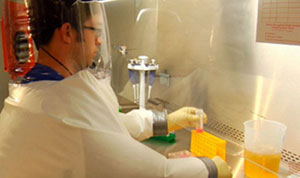Moving Towards Energy Efficient Laboratories
Executive Summary
 When designing heating, ventilation, and air conditioning (HVAC) systems, equipment loads are one of the major contributors to internal heat gains in conditioned spaces. Currently, the NIH Design Requirement Manual for Biomedical Laboratories and Animal Research Facilities (DRM) requires every lab to support at a minimum 8 watts per square foot of equipment load. Many universities and institutions have started using lower energy utilization indexes based on their studies. Utilizing higher energy utilization indexes can result to oversizing HVAC systems, which can translate to increased construction costs and increased energy use due to inefficiencies at low part-load operation.
When designing heating, ventilation, and air conditioning (HVAC) systems, equipment loads are one of the major contributors to internal heat gains in conditioned spaces. Currently, the NIH Design Requirement Manual for Biomedical Laboratories and Animal Research Facilities (DRM) requires every lab to support at a minimum 8 watts per square foot of equipment load. Many universities and institutions have started using lower energy utilization indexes based on their studies. Utilizing higher energy utilization indexes can result to oversizing HVAC systems, which can translate to increased construction costs and increased energy use due to inefficiencies at low part-load operation.
This project tested the hypothesis that equipment load design in NIH laboratories translate to oversized HVAC systems that operate at low part-load operation. Energy use of a sample of NIH laboratories was collected and analyzed. Due to the high number circuits that needed to be measured and limited energy meters, each meter was installed for one-week duration and rotated each week to measure a different circuit.
For equipment that operates constantly such as freezers, refrigerators, incubators, and biosafety cabinets, valid conclusions can be drawn about their daily energy consumption. A database is being assembled to develop energy reduction strategies by denoting other factors associated with their condition such as age, ambient temperature, time of operation, and maintenance. Based on this project, failing to provide preventative maintenance on ULT freezers and incubators translated to the units consuming 12-25% and 15% more energy, respectively. Installing timers on A2 biosafety cabinets saves approximately $250 annually. These strategies are easy to implement with very little capital investment that can translate to huge energy savings if it were adopted throughout an entire research institution.
No larger strategy recommendation can be made at this time with high degree of confidence. Because specific lab operation can vary from week to week; a longer period of data collection is needed to ensure that the full range of energy use is represented in the metered data. To supplement the data that has already been collected more energy meters would need to measure the energy consumption for all circuits in a given lab simultaneously over a longer period of time. Interviews with the lab researcher would be needed in future studies to assess the diversity of lab equipment operation to ensure maximum operating conditions are captured during the measurement period.
The NIH DRM promulgates minimum performance design standards for NIH owned and leased new buildings and renovated facilities. The NIH distributes more than 80% of its funding to almost 50,000 competitive grants to more than 300,000 researchers at more than 2,500 universities, medical schools, and other research institutions in every state and around the world and all these labs also adhere to the NIH DRM. The NIH DRM is also used internationally as the gold standard for lab design; therefore energy saving realized from right-sizing HVAC equipment would likely be replicated and expanded internationally to both public and private sector labs.
Further studies are still needed to develop equipment load database; however, the HHS Ignite (beta) program provided the catalytic resources to launch the study.
A project supported by the: HHS Ignite Accelerator
Team Members
Leo Gumapas (Project Lead), NIH
Rajib Chainani, NIH
Sy Sadighi, NIH
Don Guan, NIH
Milestones
July 2013: Selected into the HHS Ignite Accelerator
August 2013: Time in the Accelerator began
February 2014: Time in the Accelerator ended
Project Sponsor
Susan Hinton, Division of Environmental Protection, Office of Research Facilities, Office of the Director, NIH


